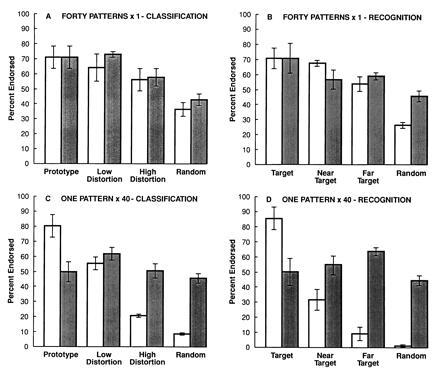Figure 6.

Each panel shows the results for four control subjects tested six times each (open bars) and the results for the profoundly amnesic patient EP (average of six tests; filled bars). (A) Classification of 84 novel dot patterns after studying 40 different training patterns (see Fig. 5 caption). Control subjects and EP performed similarly, endorsing the test items as a function of how closely they resembled the prototype of the training category (27). (B) Exactly the same task as in A but now with instructions to recognize the dot patterns that had been presented before (i.e., subjects made yes/no judgments). Actually, none of the 40 training patterns appeared on the test. Instead, the 84 test patterns varied in their resemblance to the training patterns as in A. (C) Classification of 84 novel dot patterns after studying a single dot pattern presented 40 times in succession. The training pattern was a prototype dot pattern, and the test patterns consisted of four repetitions of the prototype, 40 low distortions of the prototype, 20 high distortions of the prototype, and 40 random dot patterns. The instructions were as in A. (D) Exactly the same task was presented as in C, but now with instructions to recognize the dot patterns that had been presented before, as in B. Actually, only one dot pattern had been presented during training. The test items consisted of four repetitions of this same pattern and 80 other patterns that varied in their resemblance to the training pattern. A four-way ANOVA (EP versus controls, classification versus recognition instructions, 40 different study items versus one study item, and four types of test item) revealed significant effects of group, type of study item, and type of study item (Fs > 17.0, Ps < 0.002), but the effect of instructions fell short of significance [F(1,103) = 4.7, P = 0.06]. EP performed entirely normally at classification after seeing 40 different training patterns (A), but he performed significantly worse and at chance when he had to recognize a single pattern presented 40 times in succession (D). When asked to recognize 40 stimuli that had been presented once each (B), both EP and control subjects tended to use a classification strategy. When asked to classify after seeing only one pattern 40 times (C), normal subjects tended to rely on declarative memory, but EP could not perform the task. Subjects were more influenced by the kinds of material they studied than by the instructions given at test. Classification learning can proceed nondeclaratively when there is some variability in the training stimuli (A and B).
